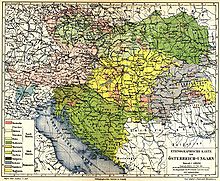- North Slavic languages
-
The term North Slavic languages (or, North Slavonic languages) has three meanings.
Contents
North versus South Slavic
It is sometimes used to combine the West Slavic and the East Slavic languages into one group, as opposed to the South Slavic languages (much like South Germanic combining the West and East Germanic branches). The Southern group was separated from the rest of the Slavic dialects by the Hungarian invasion of the 9th century.
An extinct branch of Slavic[citation needed]
Some Slavists[who?] believe that a separate, now extinct, branch of North Slavic languages once existed, different from both West and East Slavic. The dialect formerly spoken in the vicinity of Novgorod (the so-called Old Novgorod dialect) contains several Proto-Slavic archaisms that did not survive in any other Slavic language, and can in their opinion be considered a remnant of an ancient North Slavic branch.
Constructed North Slavic languages
There is also a group of artistic languages forming a fictional North Slavic branch of the Slavic languages. The authors of these languages were inspired by the existence of West, East and South Slavic languages and the absence of a (known) North Slavic group. Most of these languages therefore have an experimental character; they suppose a certain influence of the Germanic, Uralic, or Baltic languages. Despite the fact that the creators of these languages have worked independently from each other and in different time frames, these languages have several elements in common. The best-known examples of constructed North Slavic languages are: Sevorian (Sievrøsku), Nassian (Nassika), Seversk, Slavëni, and Vozgian.[1]
Notes
- ^ Tilman Berger, Vom Erfinden Slavischer Sprachen, in: M. Okuka & U. Schweier, eds., Germano-Slavistische Beiträge. Festschrift für P. Rehder zum 65. Geburtstag, München 2004, pp. 19-28 (in German).
References
- Bernard Comrie & Greville G. Corbett, The Slavonic languages (London, 1993), pp. 75 & 115-119.
- Andrii Danylenko, 2006, "The 'Greek Accusative' vs. the 'New Slavic Accusative' in the Impersonal Environment: an Areal or Structural Discrepancy?", in: Andrii Danylenko, "Slavica et Islamica. Ukrainian in Context". München: Otto Sagner Verlag, 243-265.
- Marc L. Greenberg, Uralic Influences in South Slavic
- Arne Hult, "On the verbal morphology of the South Slavic languages (in comparison with the North Slavic languages, especially Russian", Papers from First Conference on Formal Approaches to South Slavic Languages. Plovdiv October 1995. Dragvoll, University of Trondheim, Linguistics Department (= University of Trondheim. Working Papers in Linguistics 28), ss. 105-35. (23)
- Frederik Kortlandt, "Early dialectal diversity in South Slavic II", in: Dutch Contributions to the Thirteenth International Congress of Slavists, Ljubljana: Linguistics (SSGL 30). Amsterdam – New York: Rodopi, 2003, 215-235. [1]
- Frederik Kortlandt, From Proto-Indo-European to Slavic
- Gilbert C. Rappaport, "A Minimalist Approach to Case Marking in Slavic"
- Alan Timberlake, 1978, "On the History of the Velar Phonemes in North Slavic" [in Russian with English synopsis]. In Henrik Birnbaum, ed., American Contributions to the Eighth International Congress of Slavists, vol. 1, Linguistics and Poetics. Columbus, OH: Slavica Publishers.
- Hannu Tommola, 2000, "On the Perfect in North Slavic." Östen Dahl (ed.), Tense and Aspect in the Languages of Europe. Berlin: Mouton de Gruyter, 441-478.
External links
Categories:- Artistic languages
- Slavic languages
Wikimedia Foundation. 2010.

